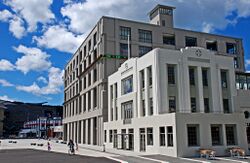Company:New Zealand Exchange
[ ⚑ ] 41°17′23″S 174°46′46″E / 41.289709°S 174.779493°E
 | |
| Type | Public company |
|---|---|
| Template:NZX S&P/NZX 50 Index | |
| Founded | 31 December 2002; predecessors dating back to 1870s |
| Headquarters | Wellington, New Zealand |
Key people | Mark Peterson (CEO) James Miller (Chair) Jon Macdonald (Director) Lindsay Wright (Director) Dr Patrick Strange (Director) Richard Bodman (Director) Frank Aldridge (Director) Nigel Babbage (Director) |
| Website | www |
NZX is at its core a markets business operating equity, debt, derivatives and energy markets. To support the development of its core markets, they provide trading, clearing, settlement, depository and data services. To ensure they are well connected to New Zealand investors, NZX owns Smartshares, New Zealand's only issuer of Exchange Traded Funds, and KiwiSaver provider SuperLife.[1]
On 1/07/2020, the NZX had a total of 178 listed securities with a combined market capitalisation of NZD$162.4 billion.[2]
History
NZX began life as a number of regional stock exchanges during the gold rush of the 1870s. Brokers’ Associations started in Dunedin Brokers’ Association in 1867, Otago in 1868, Auckland in 1872[3] and Wellington in 1882. The Dunedin Association became a Stock Exchange in 1893, Christchurch gained an exchange in 1900.[4] Auckland, Christchurch, Dunedin, Thames and Wellington formed the Stock Association of New Zealand in 1915, joined by Taranaki in 1916, Invercargill in 1920 and Gisborne in 1922.[5] Merger was investigated from 1976, Christchurch and Invercargill merged in 1978 and a national exchange was formed in 1983.[6]
In 1974 these regional exchanges were amalgamated to form one national stock exchange, the New Zealand Stock Exchange (NZSE).
On 24 June 1991, NZSE implemented a computerised trading system, and abolished the open outcry market. This computerised system was replaced with the FASTER trading system in September 1999.
On 16 October 2002 the Member Firms of the New Zealand Stock Exchange voted in favour of demutualisation, and on 31 December 2002, NZSE became a limited liability company. On 30 May 2003, New Zealand Stock Exchange Limited formally changed its name to New Zealand Exchange Limited, trading as NZX, and on 3 June 2003 listed its own securities on its main equity market.
The NZX Centre building in Wellington was originally constructed in 1907 for the C&A Odlin Timber Company, and is one of the few surviving industrial buildings in the Edwardian style.[7]
Mark Weldon was chief executive from 2002 to 2012.
In December 2002, the New Zealand Stock Exchange, as it was then known, became a listed company. It officially changed its name to the New Zealand Exchange Limited around six months later and now trades as NZX.
In 2009, NZX made a number of acquisitions in the rural sector, including a Feilding-based publications business and the Clear Grain Exchange in Melbourne.
In May 2012 Tim Bennett replaced Mark Weldon as NZX's CEO, returning from Singapore to take up the position.
In October 2016 Tim Bennett announced that he would step down from his position as CEO on 31 December 2016. NZX's Head of Markets, Mark Peterson, stepped in as interim CEO on January 1, 2017, becoming CEO on a permanent basis from April 2017.[8]
Principal activities
The principal activities of NZX are:
- An operator and regulator of securities and derivatives markets and provider of trading, post-trade and data services for securities and derivatives, as well as the provider of a central securities depository. NZX is the only registered securities exchange in New Zealand, and is also an authorised futures exchange. Its wholly owned subsidiary, New Zealand Clearing and Depository Corporation, is the operator of a designated settlement system under Part 5 of the Reserve Bank of New Zealand Act 1989.
- A provider of passive funds management products through the Smartshares family of Exchange Traded Funds (ETFs) and a provider of superannuation, KiwiSaver, and investment products through SuperLife, acquired in 2015.
- Market operator for New Zealand's wholesale electricity market, under contract from the Electricity Authority, and the Fonterra Shareholders’ Market, under contract from Fonterra.
Trading hours
NZX Main Board (NZSX) – normal trading hours 10am – 4:45pm
NZX Alternative Market (NZAX) – normal trading hours 10am – 4:45pm
NZX Debt Market (NZDX) – normal trading hours 9am – 4:45pm
Dairy Derivatives – normal trading 7am – 10pm.[9]
See also
- NZX 50 Index
- List of companies listed on the New Zealand Exchange
- List of companies delisted from the New Zealand Exchange
- List of stock exchanges in the Commonwealth of Nations
References
- ↑ "NZX Group". http://www.nzxgroup.com/.
- ↑ "NZX listings". https://www.nzx.com/markets/nzsx.
- ↑ "Story: Stock market Page 1 – First stock exchanges". http://www.teara.govt.nz/en/stock-market/page-1.
- ↑ "Page 2 – Financing the gold-dredging boom". http://www.teara.govt.nz/en/stock-market/page-2.
- ↑ "Page 3 – Quiet consolidation, 1900–1950". http://www.teara.govt.nz/en/stock-market/page-3.
- ↑ "Page 4 – Towards a national exchange, 1950–1984". http://www.teara.govt.nz/en/stock-market/page-4.
- ↑ "The Former Odlin Building - NZX Centre". Wellington Waterfront. http://www.wellingtonwaterfront.co.nz/development/Taranaki_street_wharf/odlin_building/index.htm.
- ↑ "NZX Appoints Mark Peterson as its Interim CEO". Finance Magnates. http://www.financemagnates.com/executives/moves/nzx-appoints-mark-peterson-as-its-interim-ceo/.
- ↑ https://www.nzx.com/investing/nzx-trading-hours
External links


